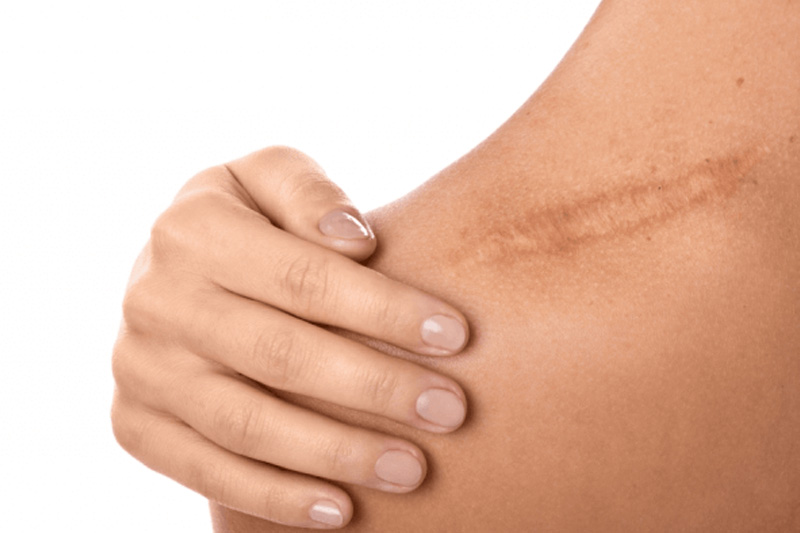
Treat your Blemished Skin with Scar Treatment
No Need for Conspicuous Scars!
Overview of a Scar Correction
| Indications for Surgery | Problematic scars |
| Treatment Period | Depending on extent: Half an hour to two hours |
| Anaesthetic | Depending on extent: local or general anaesthesia |
| Patient Stay | Depending on extent: outpatient or inpatient at the Privatklinik am Wittenbergplatz, Germany |
| Inactive Period | Depending on extent: One to ten days |
| Costs | Depending on the size: 300 – 3000 € |
| Post-Treatment | controls, scar care |
| Sport | Depending on extent: After a few days up to three weeks |
Scars as Wound Healers
When a person has been injured, the body heals this injury and as a result of the wound healing, a scar forms.
Such healing can go smoothly and leave an inconspicuous, non-irritant scar. Or it can be accompanied by considerable problems, if this happens a scar correction might be necessary, for example:
The wound cannot heal in the first place and then a chronic wound develops or If it has healed – with problems – the scar will hurt, itch, impair function and / or be conspicuous, i.e. bulging, wide, red, these scars can be treated with surgery.
Causes of Scarring
Scarring can cause problems under the following circumstances:
predisposition: One has a genetic predisposition for conspicuous scars and a keloid or hypertrophic scar forms.
Lack of calm: During healing, the wound is irritated, strained and moved.
Wound closure under tension: The surgeon closes the surgical wound by pulling on the wound edges.
Infection: Germs get into the wound, it does not heal properly and therefore closes much later, i.e. secondarily and a wound healing disorder develops.
Wound healing disorders can also arise from other causes: Hematoma (bruising), seroma (accumulation of tissue water), lymphocele (accumulation of lymph), foreign bodies (dirt particles, threads).
Skin diseases, for example acne
burns
Do Scars Pose a Health Risk?
A noticeable scar can cause the following problems:
- pain
- itching
- impairment of function
- Aesthetically unpleasant , i.e. it is broad, bulging, red/livid.
If a conspicuous scar develops after an injury, operation or burn, It is better to wait at least 6 months as more often than not, the scar may heal nicely by itself. If this is not the case then surgical intervention might be an option.
Objective of Scar Treatment
The aim of scar treatment is to eliminate all the symptoms mentioned above and although the the symptoms will always success, the elimination of the scar tissue entirely is not always possible.
However, invisible scars do not exist! This is biologically impossible. A certain amount of visible residue always remains after the scar correction.
Procedure of the Treatment
The following procedures are available to improve a symptomatic scar:
The operation: The scar is cut out, healthy tissue from the surrounding area is mobilized and swivelled into the defect left behind by the cut out scar. Relieving inner sutures minimize the wound tension.
The laser: If the scar is red/livid, this is caused by the blood vessels that remain in the scar. They are closed with the laser and the scar becomes light.
The medical tattoo: Here colour pigments, which have the same tint as the normal, healthy blemished skin, are introduced into the scar. This makes it much less conspicuous, this has nothing to do with a decorative tattoo.
Cortisone: Cortisone reduces the growth of a scar, this especially helps with keloid.
Follow-up Treatment
When our patients go home, they get everything they need: Painkillers (little, it doesn’t hurt very much), my mobile number (just in case), advice and a check-up appointment.
We check if everything heals properly.
After two weeks the stitches are removed, after three months the final result is achieved.
After the sutures have been removed, we recommend treatment with silicone gel as It is the only substance whose effect has been proven. It also improves the appearance of the scar and is applied over a period of at least three, preferably six months.
Injections of cortisone into the scar can also help the healing.
Risks/Complications
Sometimes a situation arises where patients tend to have conspicuous scars, i.e. there is a genetic predisposition for them, this causes keloids or hypertrophic scars to develop. People with dark skin tend to be more prone to it than light skinned people, although you cannot operate on these types of scars if this is known beforehand, precautions can be taken: The injection of cortisone, pressure pads made of silicone, etc. can also be used.
Another piece of advice: Do not use miracle cures to mysteriously remove the scar, something like this cannot work and only helps the manufacturer, not you!
When is it not Advisable to Undergo Surgery?
Severe underlying diseases prohibit the operation.
Fresh scars must first mature and given a chance to improve themselves. Infections in the scar must heal first.
In the case of keloids, surgical therapy must be restrained.
Costs/Reimbursement by the Health Insurance Company
As a rule, the costs are to be borne by the patient. If the scar restricts the function, an application for coverage can be made.
Further Information
The following authors have dealt extensively with this topic: T. Mustoe, A. Widgerow
